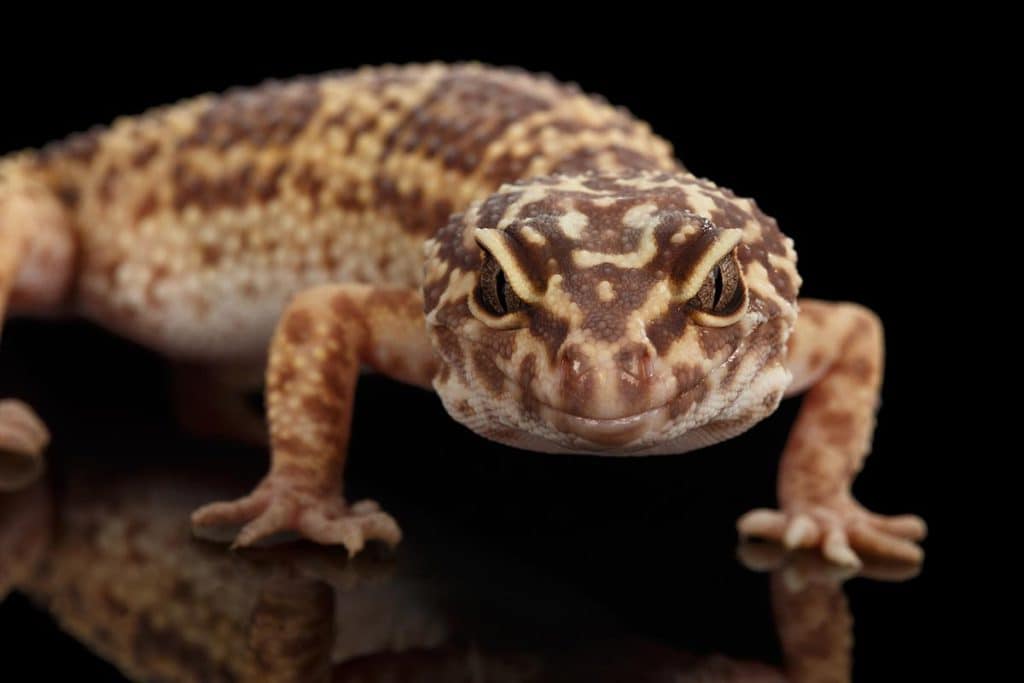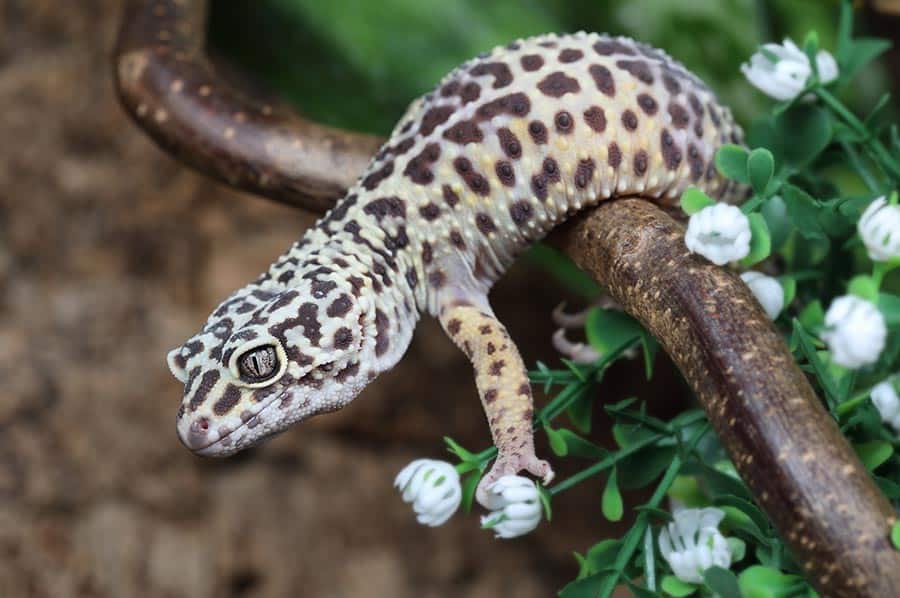Leopard geckos are popular beginner reptile pets because of their friendly nature, adorable smiles, simple care needs, and their small size. They are the perfect handful-sized lizard! But exactly how big do leopard geckos get, anyway?
Leopard geckos start off at about 3 inches long when they first hatch and can grow to around 8 to 11 inches once they are fully mature. Roughly 10 inches from nose to tail tip is the average length of most adult leopard geckos.
However, these reptiles can suffer from certain illnesses or poor husbandry issues that will slow or halt their growth completely. These factors are easily identified and rectified if you have patience and love for your leopard gecko!
It is important to remember that, above all, leopard gecko size is primarily determined by genetics. There are many things you can do to make sure your leopard gecko will get as big as it genetically can. You cannot make it grow bigger than its genes will allow, but you can ensure they grow to and maintain a healthy size by giving them proper care throughout their life.
Leopard Gecko Growth Rate
Leopard geckos start off at approximately 3 inches long, which is quite large for coming straight out of an egg! They grow quite quickly in their early stages (baby to juvenile), and then their growth slows down from the time they are subadult until they are fully mature at around 18 months.
Here’s a chart to give you an idea of how much your gecko should weigh and how long they should be at each growth stage.
The bulk of a leopard gecko’s growth is weight gain. They start off quite long as hatchlings and end up being on average 8 to 11 inches long; this is not a huge jump in length like what some other lizards experience. Leopard geckos fatten up significantly as they grow to maturity.
Most of the weight leopard geckos gain as they age goes to their tails, which act as fat storage. Their small size and docile temperament make them excellent lizards for handling. They are small enough to be a handful and big enough that they feel secure in your hand and are not likely to be hurt by accidental squeezing.
Males are generally bigger than females both in length and weight. This slight size disparity is normal, so do not worry if your male and female geckos are growing at different rates! Males of most lizard species are larger than females.
Factors That Can Boost Leopard Gecko Size
How big do leopard geckos get? While they can only grow as large as their genetics will allow, there are many factors that will ensure they grow at a healthy rate and reach their maximum size. Here are a few things to keep in mind when caring for your gecko that will positively affect their growth.
Diverse Diet
Offering your gecko a diverse and healthy diet is essential in helping them grow to be as big as they can be.
A leopard gecko’s diet is strictly insectivorous. This means they only eat insects. They should never be fed vegetables or fruit because their digestive systems are not designed to handle the cellulose present in plant material.
Baby and juvenile leopard geckos should be fed daily to accommodate their rapid metabolisms, while subadults and adults can be fed every second day.
Leopard geckos need to be fed a variety of insects because each insect has its own nutritional content. Only feeding your leopard gecko crickets, for instance, can cause a nutritional deficiency.
Be sure to offer your gecko a wide variety of safe insects. Regular or “staple” feeders can include:
- Phoenix worms (also known as black soldier fly larvae)
- Crickets
- Dubia roaches
- Hornworms
- Butterworms
- Beetles
- Silkworms
- Mealworms
- Superworms
To make sure your leopard gecko gets all of its vital nutrients, gut load your insects 12 to 24 hours before feeding time. Gut loading is the process of feeding your insects vegetables and fruits that are high in vitamins so that those vitamins can be passed onto your gecko in a way that they can absorb them.
You can also include a
Exercise and Enrichment
Leopard geckos are active creatures. They need space to roam in their enclosures. While they do not need very large enclosures, they must be able to move freely and quickly. If they are cramped in a 20-gallon enclosure for their whole lives, they will not have the space to move around.
Exercise provides mental stimulation for leopard geckos. Without enrichment, they can become very bored. Bored animals can become listless, depressed, and lethargic and will not be very active. Increased activity and exercise encourage healthy muscle attachments to develop, which leads to strong bones and good growth.
If you cannot have a large enclosure to allow your leopard gecko to move around, then ensure that you handle your leopard gecko regularly and provide it with a safe space to run around to get their exercise in. Ideally, an adult leopard gecko should be housed in an enclosure that is at least 30 gallons or so.
Factors That Inhibit Leopard Gecko Growth
While there are plenty of ways to maximize your leopard gecko’s size, there are also plenty of factors that can slow their growth or stunt their development entirely. Here are the main factors that can limit your gecko from growing to a healthy length and weight.
Parasites
Parasites actively steal nutrients from their hosts. If a growing leopard gecko has internal or external parasites, their nutrients will be stolen from them before they get a chance to use them to grow.
On top of this nutritional heist, parasites make their hosts sick with other illnesses that further inhibit their growth.
If you suspect your leopard gecko has parasites, get them to the vet as soon as you can to prevent lasting damage from being done. Your vet will likely need to conduct tests to confirm the presence of parasites and then prescribe certain medications to either flush out your gecko’s system or remove external parasites like mites.
Metabolic Bone Disorder (MBD)
Metabolic bone disorder happens when a reptile does not get sufficient
It is important to remember that severe MBD is completely irreversible. While more minor cases can be slowed or reversed to an extent, once severe damage is done, it is done for life. This is why feeding your leopard gecko a diverse diet with the proper vitamin supplements is essential for their overall health and ensuring that they reach their full size.
Poor Husbandry Practices
Keeping leopard geckos in dirty enclosures with incorrect lighting and heating will stunt their growth.
Geckos are cold-blooded reptiles who must thermoregulate to stay warm. This means without the correct heating they cannot perform all of their metabolic functions correctly, which includes things like bone development, organ development, and muscle growth.
If your leopard gecko is kept in an enclosure that has poor humidity control, they can suffer from respiratory illnesses (high humidity) which will stunt their growth. If humidity is too low, they will become dehydrated and suffer from toe and tail loss if their skin becomes so dry that it cuts off circulation.
To understand leopard gecko shedding, check out our article dedicated to how often leopard geckos shed their skin.
Stress
Stressed out leopard geckos do not eat properly and will therefore not grow to their full capacity. Make sure to look out for signs of stress early on and always address their causes promptly.
Some common causes of stress are:
- The enclosure is in a busy part of the home or is near other pets or small children
- The lighting set up in the enclosure does not provide a proper photocycle
- The temperature gradient is not correct or the enclosure is not warm enough
- Their feeder insects are too big to safely eat
Tail Autotomy
Leopard geckos are really cool because they can drop and regrow their tails! This is called tail autotomy. If they feel threatened, get frightened, or feel very stressed, leopard geckos will drop their tails as a distraction for a predator so they can safely get away.
Unfortunately, this means that their bodies will then expend a large amount of energy in regrowing the dropped tail instead of following a proper growth pattern.
If your gecko is continuously dropping its tail, it will suffer from stunted growth. If this is happening regularly, make sure you look out for what could be stressing your pet out. Always provide them with extra nutritious food during this time so they can regrow their tail properly.
Bullying/Cohabitation
Leopard geckos are territorial lizards, which means they do not typically live in groups in the wild. However, you can keep two leopard geckos in the same enclosure, provided the enclosure is 40+ gallons and has two sources of water and multiple hides.
Additionally, always avoid cohabitating male geckos; if you want to house two in the same enclosure, be sure they are either both female or a male and female breeding pair.
These precautions need to be taken because the more dominant leopard gecko will bully the other for resources. The bullied gecko will then lack proper nutrition, water, and safe spaces to rest and recover which will stunt their growth.
Special Leopard Gecko Giant Morphs
Some specialized morphs are giant or supergiant leopard geckos that reach and exceed 12 inches and weigh in at approximately 150 grams or more! Those chunky little geckos will cost a lot more than regular-sized leopard geckos, and they are usually harder to find as they are of a specific niche.
Scurrying Off…
Leopard geckos make amazing pets. They are friendly, they can vocalize, they have adorable smiles, and they are the perfect size for handling. Leos start off at 3 inches long when they hatch and grow rapidly to 8 to 11 inches in length once they mature at 12 to 18 months.
If you maintain proper husbandry and a varied, healthy diet, then your leopard gecko will easily reach its full size. Keep an eye out for the factors that can negatively affect how big leopard geckos get, such as stress and illness. Good luck!




